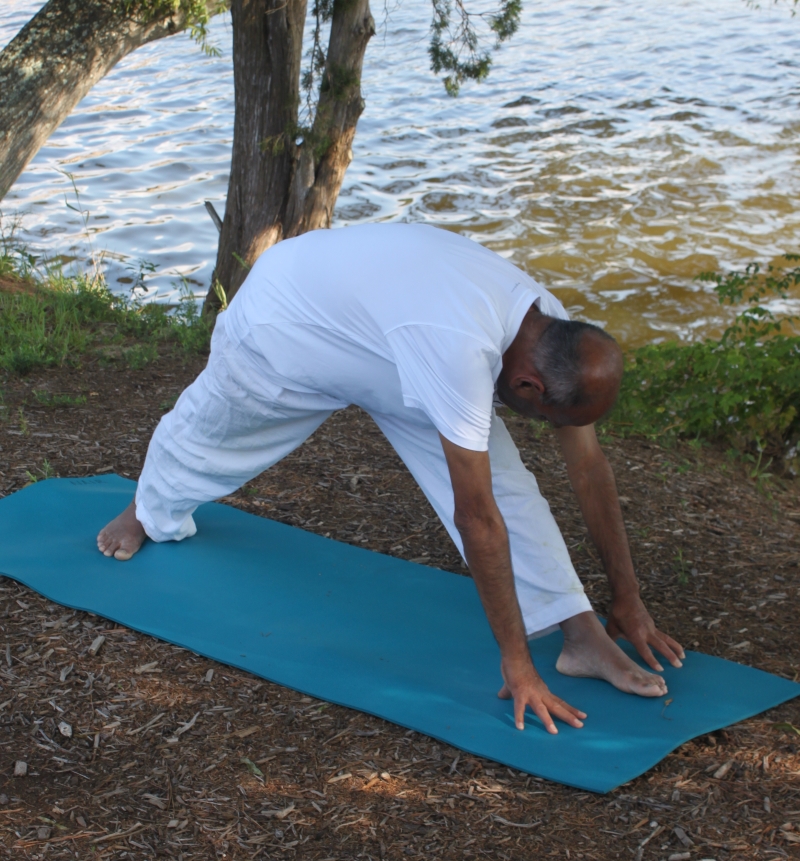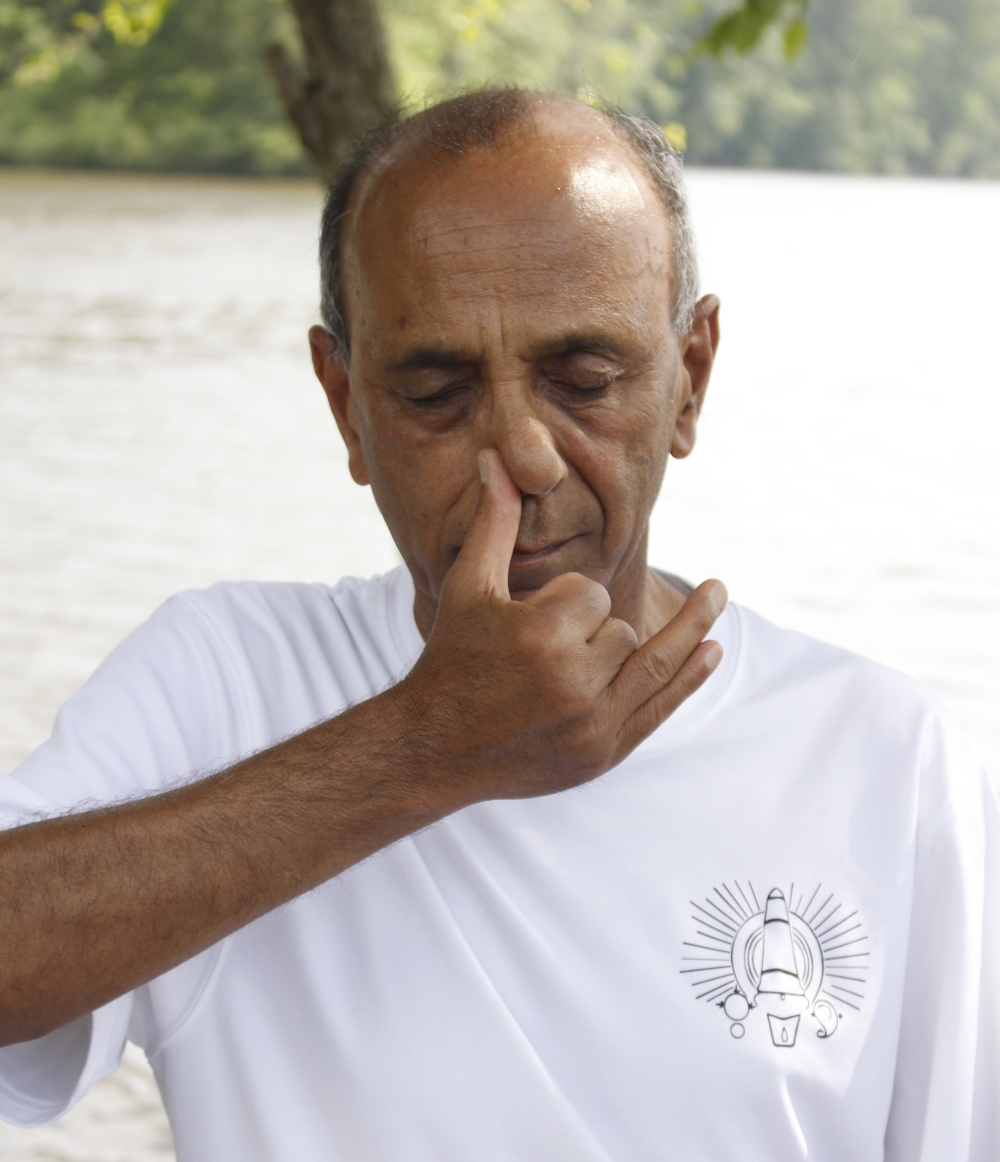
Parshvottanasana (intense side stretch)
In some of my previous posts I have discussed the need for and the importance of establishing a home-based yoga practice. As we know, it is only through a regular home practice that we can realize all the benefits that yoga can offer. Moreover, as I like to emphasize in my classes, yoga practice must include all the three major components – asana (physical postures), pranayama (breathing practices) and meditation. So, ideally your practice should include all three. If you are strapped for time, you can split these practices during different times of the day as long as you give yourself a gap of about three hours after a full meal. For example, you can do asana and pranayama in the morning and meditation in the evening, or vice versa.
The most common reason that I hear for not practicing at home is lack of time. It is true that both job and family life demand a lot of time and attention. However, if we can set our priorities right, it is always possible to find the time needed for a yoga routine.
Given the paucity of time, many of my students ask me to recommend a "bare minimum" practice that they can do on a daily basis. They can do a more complete routine as and when they find the time. I firmly believe that when you establish a daily routine, even though for a short duration, you will start realizing the benefits of the practice. Once you notice the benefits, you are likely to be motivated to spend more time on your practice.
I am giving below my recommendations for a daily practice that you can establish depending upon how much time you have available on a given day.

Nadi Shuddhi Pranayama
The bare minimum (20 min)
- Marjarasana (Cat and Cow) (2 min)
- Surya Namaskar (Sun Salutation) (8 min)
- Pranayama: kapalabhati, ujjayi pranayama, alternate nostril breathing (10 min)
Basic (30 min)
- Marjarasana (Cat and Cow) (2 min)
- Surya Namaskar (Sun Salutation)(8 min)
- Pranayama: kapalabhati, ujjayi pranayama, alternate nostril breathing (10 min)
- Meditation (10 min)
Minimal (45 min)
- Centering and Om chanting(2 min)
- Marjarasana (Cat and Cow) (2 min)
- Surya Namaskar (10 min)
- Dhanurasana (Bow pose) (2 min)
- Janu-shirshasana (head-to-knee pose) (2 min)
- Pashchimottanasana (full forward bend) (1 min)
- Shoulder Stand (Sarvangasana) (3 min)
- Fish pose (Matsyasana) (1 min)
- Ardha-matsyendrasana (spinal twist) (2 min)
- Pranayama: kapalabhati, ujjayi pranayama, alternate nostril breathing (10 min)
- Meditation (10 min)
Highly Recommended (one hour routine)
Asana (25 min)
- Centering and Om chanting
- Marjarasana (Cat and Cow)
- Surya Namaskar (Sun Salutation) – 4 rounds (with or without the Surya Namaskar mantras)
- Shalabhasana (Locust)
- Dhanurasana (Bow pose)
- Janu-shirshasana (head-to-knee pose)
- Pashchimottanasana (full forward bend)
- Setu-bandhasana (Bridge pose) or Shoulder Stand/Fish Pose
- Ardha-matsyendrasana (spinal twist)
- Yoga Mudra
Yoga Nidra (deep relaxation in Shavasana) – (5 min)
Pranayama (15 min)
- Ujjayi pranayama (deep 3-part breathing)
- Kapalabhati (3 rounds, approximately 100 strokes in each round)
- Rapid breathing (one nostril at a time, then both nostrils)
- Bhramari (humming bee)
- Naadi Shuddhi (aka Anuloma-viloma/alternate nostril breathing)
Meditation (15 min)
- Om chanting
- Meditation using body awareness, breath awareness, third eye awareness followed by mantra meditation.
I discussed this one hour routine on my blog some time ago.
Ideal (Full 90-minute routine)
Asana (40 min)
- Centering and Om chanting
- Marjarasana (Cat and Cow)
- Surya Namaskar (Sun Salutation) – 3-4 rounds (with variations like warrior pose, triangle/reverse triangle pose etc.)
- Balancing pose (Tree pose/Dancer’s pose/Eagle pose/warrior 3 etc.)
- Shalabhasana (Locust)
- Dhanurasana (Bow pose)
- Janu-shirshasana (head-to-knee pose)
- Pashchimottanasana (full forward bend)
- Shoulder Stand (Sarvangasana)
- Fish pose (Matsyasana)
- Setu-bandhasana (Bridge pose)
- Pawana-muktasana (wind-relieving pose)
- Ardha-matsyendrasana (spinal twist)
- Yoga Mudra
Yoga Nidra (deep relaxation in Shavasana) – (10 min)
Pranayama (20 min)
- Ujjayi pranayama (deep 3-part breathing)
- Kapalabhati (3 rounds, approximately 100 strokes in each round)
- Bhastrika (bellows breath) (2 rounds, approximately 20 strokes in each round)
- Rapid breathing (one nostril at a time, then both nostrils)
- Bhramari (humming bee)
- Naadi Shuddhi (aka Anuloma-viloma/alternate nostril breathing)
Meditation (20 min)
- Om chanting
- Meditation using your favorite “dharana” practice followed by mantra meditation.
I encourage you to get the set of two video DVDs that I offer for establishing your home routine. The first of these videos is on the asana practice (about 50 min) and the second one (about 40 min) covers deep relaxation, pranayama and meditation.
I would love to hear about your own home practice. Please provide your feedback or share your own experience in the comments section.
Recent Comments